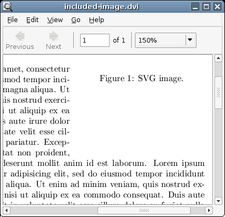Device independent file format

|
|
| Filename extension | .dvi |
|---|---|
| Internet media type |
application/x-dvi (unofficial) |
| Developed by | David R. Fuchs |
| Type of format | document |
The device independent file format (DVI) is the output file format of the TeX typesetting program, designed by David R. Fuchs and implemented by Donald E. Knuth in 1982. Unlike the TeX markup files used to generate them, DVI files are not intended to be human-readable; they consist of binary data describing the visual layout of a document in a manner not reliant on any specific image format, display hardware or printer. DVI files are typically used as input to a second program (called a DVI driver) which translates DVI files to graphical data. For example, most TeX software packages include a program for previewing DVI files on a user's computer display; this program is a driver. Drivers are also used to convert from DVI to popular page description languages (e.g. PostScript, PDF) and for printing.
DVI is not a document encryption format, and TeX markup may be at least partially reverse-engineered from DVI files, although this process is unlikely to produce high-level constructs identical to those present in the original markup, especially if the original markup used high-level TeX extensions (e.g. LaTeX).
DVI differs from PostScript and PDF in that it does not support any form of font embedding. (Both PostScript and PDF formats can either embed their fonts inside the documents, or reference external ones.) For a DVI file to be printed or even properly previewed, the fonts it references must be already installed. Also, unlike PostScript (but like PDF), DVI is not a full, Turing-complete programming language, though it does use a limited sort of machine language.
...
Wikipedia
